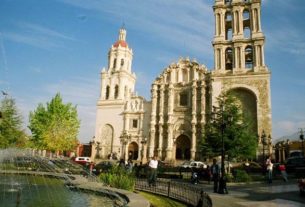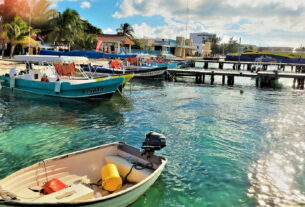Dateline – La Ceiba, Puebla, Mexico
The Artist and Curandero: continued.
La Ceiba is a small town in the state of Puebla on the highway between Mexico City and Poza Rica, Veracruz. It’s about 45 minutes from Poza Rica. The town was named after a large ceiba tree that once grew in the plaza. The name of the town has actually been changed to that of some historical figure, a fact which I choose to ignore, as do most of the people who live there. (Unless you specifically don’t want to, I suggest including the town’s changed name. It will save a lot of email later.)
Efrain is probably in his mid-fifties. He is of average height for a Mexican, around five feet five inches or maybe a little taller. He has grayish hair, about the color of mine. I was a little disappointed when one time I visited and found he had dyed his hair black. What the hell, it’s his hair. I never asked him why he did it.
Efrain is generally quite poor. I stopped by to see him one day and there was a new red convertible sports car parked outside. Inside Efrain sat in his somewhat dirty T-shirt, pants that were just a little too small, huaraches (sandals) without socks, a mop of uncombed hair. His teeth are in worse condition than mine. His well-dressed friend from Mexico City was giving him hell because he didn’t take care of himself and didn’t charge more for his work. Efrain is generally a humble person but is not easily intimidated. He thinks fast.
Efrain’s main responsibility in life (he’s not married and doesn’t have any children), is trying to help provide a meager livelihood for kids and young men who drift in and out of his shop. Sometimes they sleep in his storeroom. Some help him with the creation of his art projects, and others search the woods and rivers for materials. When Efrain is “down in the dumps ” it is generally because he doesn’t have money for the kids, the rent is past due, no money for supplies, or the telephone has been disconnected because he couldn’t pay the phone bill. Let’s face it, most creative artists don’t manage money very well.
Felix has worked with Efrain for many years. It is something of a father and son relationship. Felix says Efrain is the brains and he is the hands. Efrain does the creative thinking and design and Felix does much of the actual work, and does it well. Felix is Totonaca. He understands the language and his mother speaks Totonaca fluently. However, Felix was brought up to speak Spanish. He has a small farm outside of town where he lives with his family and grows some coffee etc. Every day he comes into town and works in the shop. He is a good natured and a very likeable person. He seems to fare a little better than Efrain.
Some of the items produced in the shop are wooden crucifixes. Efrain has been making them for 20 or 30 years. The cross is generally made from the trunk or branch of a coffee tree plant and the Christ figure carved from the root of the coffee tree. The hair and beard are of the fiber in the bark. I don’t know from which plant the crown of thorns is taken, but it is from a natural plant. The loincloth is of dried corn-husk. The work is beautiful and most Mexicans view these pieces with reverence. When I took them to the U.S.A., I had to just lay them on top of other things because they were difficult to pack. It seemed to make going through check-points easier because of the respect even the most hardened Mexican official had for the image. I even sold one to a customs inspector. A federal police officer simply confiscated one “for his comandante”. The permit on my vehicle had recently expired so I didn’t argue with him.
One of these crucifixus now resides in the home of a very wealthy, very Catholic man in Ireland who was on the Board of Regents with Lloyds of London. I sold a number of them to a respected art gallery in San Antonio. A few days ago I had an urgent phone call from a friend in the U.S.A. who had promised one to someone in Vancouver, British Columbia. I haven’t been able to get in touch with Efrain. His phone has apparently been disconnected again.
Another unique item they make are pictures, in recessed frames, created entirely from butterfly wings. The pictures are usually of flowers or other plants and birds. Efrain does the design work and Felix patiently shapes hundreds of tiny pieces and forms the picture. The colors are brilliant and fast and the end result is beautiful.
I do not debate the morality of killing a butterfly for the sake of art. Some people cringe at the thought. Perhaps it is because the butterfly is such a beautiful creature.
Or maybe it’s an inconsistency in human nature. Most people have no qualms about devouring a thick juicy steak. Anyway, the butterfly has a short life span and their beauty is preserved forever in the work of Efrain and Felix.
Efrain is also a practitioner of herbal medicine or curandero. Apparently most of his income is derived from this source. He was taught the skills by his mother, who probably was taught by her mother. He claims to have a cure for AIDs and cancer if they are not too advanced. Whether it is true or not I could not say. Being completely honest is not a requirement for friendship, in my case. I do not know anyone that is completely honest. I know people who do not know the meaning of the word. In any case, he has apparently treated some very influential people from various parts of Mexico.
I guess I’ll have to make a trip to La Ceiba since I can’t reach Efrain by phone. I need some things for the shop I opened a few days ago. Perhaps I can put together an exhibit of his work in Tlaxco.


